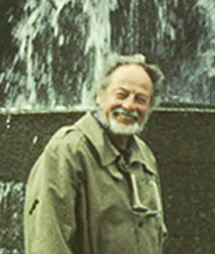
Lawrence Halprin
Lawrence Halprin (July 1, 1916 – October 25, 2009) was an American landscape architect, designer and teacher.[1]
Lawrence Halprin
July 1, 1916
October 25, 2009 (aged 93)
Architect
2, including Daria Halprin
Ruthanna Hopper (granddaughter), Dennis Hopper (former-son-in-law)
Lawrence Halprin & Associates
Beginning his career in the San Francisco Bay Area, California, in 1949, Halprin often collaborated with a local circle of modernist architects on relatively modest projects. These figures included William Wurster, Joseph Esherick, Vernon DeMars, Mario J. Ciampi, and others associated with UC Berkeley. Gradually accumulating a regional reputation in the northwest, Halprin first came to national attention with his work at the 1962 Seattle World's Fair, the Ghirardelli Square adaptive-reuse project in San Francisco, and the landmark pedestrian street / transit mall Nicollet Mall in Minneapolis. Halprin's career proved influential to an entire generation in his specific design solutions, his emphasis on user experience to develop those solutions, and his collaborative design process.
Halprin's point of view and practice are summarized in his definition of modernism:
In his best work, he construed landscape architecture as narrative.[3]
Early and personal life[edit]
Halprin grew up in Brooklyn, New York, the son of Zionist leader Rose Halprin and Samuel W. Halprin. As a schoolboy, he earned acclaim playing sandlot baseball. He credited his parents with introducing him to art and supporting his artistic inclinations. His mother, in particular, brought him along on her weekly shopping trips to Macy's, after which they would visit the Metropolitan Museum of Art.[4]: 2 Being Jewish,[5][6] after finishing Poly Prep at 16, he went to Israel on a kibbutz for three years near what is today the Israeli port city of Haifa.[4]: 3–5 [7]
He earned a Bachelor of Science degree in 1939 at Cornell University, studying horticulture with Professor Lee Gand;[4]: 5 he continued his studies at the University of Wisconsin, where he earned a Master of Science.[8] While at Wisconsin, his wife Anna convinced Halprin to visit Taliesin, Frank Lloyd Wright's studio in Wisconsin, which in turn sparked Halprin's initial interest in architecture;[7] after he left Talesin, he went to the school library, where he found and was inspired by Christopher Tunnard's Gardens in the Modern Landscape. Returning to school the following Monday, he spoke with the department head of horticulture, who directed him to the landscape architecture group upstairs, where he met Professor Franz Aust. After two weeks, Professor Aust recommended he continue his studies at the Harvard Graduate School of Design.[4]: 5–6 There he earned a second bachelor's degree (in landscape architecture, awarded 1942), where his professors included architects Walter Gropius and Marcel Breuer.[9] Although Tunnard was teaching at Harvard, he never took a course from him. His Harvard classmates included Catherine Bauer, Philip Johnson, I.M. Pei, and William Wurster.[4]: 8
In 1944, Halprin was commissioned in the United States Navy as a Lieutenant (junior grade). He was assigned to the destroyer USS Morris in the Pacific which was struck by a kamikaze attack. After surviving the destruction of the Morris, Halprin was sent to San Francisco on leave. It was there he would stay following his discharge.
Halprin and his wife, accomplished avant-garde dancer Anna Halprin (née Schuman), were married in 1940.[8] The couple were long-time collaborators; together, they explored the common areas between choreography and the way users move through a public space.[4]: 35 [10] They have two daughters: Daria Halprin, an American psychologist, author, dancer, and actress, and Rana Halprin, a photographer and activist for Romani and human rights.[9]